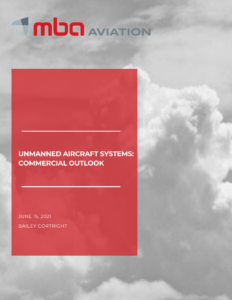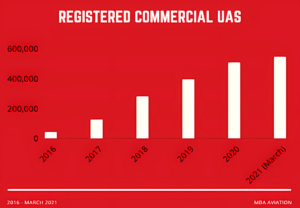
June 15, 2021
Unmanned Aircraft Systems: Commercial Outlook
by Bailey Cortright
Unmanned Aircraft Systems – Commercial Outlook
Since the introduction of FAA Part 107 in 2016, small, unmanned aircraft systems (sUAS) use has grown at a blazingly fast pace. At the end of 2016 there were 42,000 registered commercial sUAS; roughly 4 years later that number has reached 545,000. That is nearly a 1,200% increase! Furthermore, these numbers only account for sUAS under Part 107. There is still a significant quantity of commercial UAS that are flown under a Section 333 exemption. The FAA estimates that the number of commercial UAS will double by 2024, which would put the total at roughly 1.1 million.

No other industry is growing at this pace, so why are sUAS the exception? There are two main reasons for this explosive growth. The first is the broadening use and success of sUAS in various applications with new uses for sUAS seeming to come about daily. Additionally, they continue to prove their worth and solidify their use in construction, infrastructure inspection, agriculture, and public safety applications. The second likely reason of accelerated growth is the relaxation of UAS regulations, which makes this technology more accessible. One example of this relaxation is that as of April 2021, the FAA has removed the need for operators to obtain a waiver to fly at night. Pilots will be able to take advantage of this new rule provided they have completed their recurrent training prescribed by the FAA. This allows for more hours in the day that sUAS can be flown and opens the door to previously unavailable applications.
Commercial UAS Core Competencies
Construction
- Mapping the Site
- Measuring Structures
- Safety Inspections
- Progress Updates
- Worker Monitoring
- Logistics Planning
Agriculture
- Crop Health Analysis
- Spot Treatment of Herbicides
- Yield Estimation
- Large Scale Soil Analysis
- Plant Pollination
Infrastructure Inspection
- Measure Wear and Tear
- Eliminate the Need for a Helicopter
- Access Hard to Reach Areas
- Enter Areas too Dangerous for Humans
Breakdown of the Unmanned ‘System’
These three sectors are just a small portion of what sUAS are capable of and their uses go far beyond the bullets listed above. Additionally, the types of sUAS used for different jobs varies widely. Unmanned Aircraft Systems (UAS) can be anatomically different, whether they are a fixed wing, quadcopter, or rotorcraft there are all meticulously designed to perform their job exceptionally well. Despite these differences all UAS are made up of 4 basic components. The four basic components consist of the aircraft itself, the ground station, the payload, and the data link. A ground station can be many things so long as it allows for human interface. This could be as simple as basic remote controller but could also be a complex system that takes up a whole room or perhaps even a building. Following that would be the payload which is probably the vaguest of the four. It is defined as the weight (cargo/passengers/sensors) that the aircraft can carry that is not related to the flight operation of the aircraft. Most of the time, this is a camera or some other form of remote sensing, but it could also be a package if the UAS were tasked with a delivery mission. Lastly there is the datalink which is the means that is used to communicate within the UAS. In most cases, the datalink is radio frequency, but it can also be Wi-Fi or satellite based. Additionally, the datalink can be a hybrid of telecommunications. Radio datalinks can be used from the ground station to the aircraft to control flight surfaces along with a separate frequency to send live video from the unmanned aircraft (UA) back to the ground station. In addition to that there is often a satellite-based component that only interacts with the UA for navigation purposes. All four of these components are essential to the system and the failure of component will lead to the failure of the system.
Technical Progress
sUAS have not been widely available until recently. The debut of the commercial sUAS as we know them today was in 2010 when a French company released their first UAS which was the first of its kind that was widely available to consumers. Since then, this market has exploded due to the overwhelming utility and cast applications that sUAS provide. This utility component has been compounded over the past decade as advancements in SWAP (size, weight, and power) technologies were made with continued advancements. This has allowed sensing payloads that were previously too large and heavy to fit, to now be compatible with small aerial platforms. Most recently LIDAR sensors have been the latest addition to the suite of sensors that sUAS can now field. This new capability has been making waves in the industry allowing for more precise measurements and volumetrics, which has significantly benefited the construction and mining industries.
Large Commercial UAS (Part 135)
Ther are only a few companies that have opted to pursue a FAA Part 135 approach. This is the same regulatory umbrella that governs small manned commercial aviation operations such as air taxis. A key advantage of this approach is that these companies will not be limited by the size of their UAS or the quantity of the operations. It also allows them to perform deliveries for compensation which is also a provision under Part 107. Operating a UAS ‘airline’ as 135 is tricky and requires waiving many of the rules associated with the regulation. Examples of waived rules include “the pilot must wear a seatbelt” or “copies of flight procedures must be kept on the aircraft.” These rules are obviously irrelevant to UAS operations but must be waived regardless. All the companies operating under this regulation are pursuing package delivery. For the time being, this will be the most popular application of larger UAS. Once large UAS regulations start to relax then we may see UAS moving into other heavy lift roles, whether it be air taxi or upgrading existing application such as larger tanks for the agricultural sector.
UAS and the National Airspace System
Integrating unmanned aircraft within the National Airspace System has been a regulatory challenge and still deep in the developmental stage. Unmanned aircraft can takeoff from anywhere, which means, there is no point source that can be regulated, unlike an airport. There have been some helpful advancements that have streamlined sUAS operations. For example, previously, at the release of Part 107, if operators wanted to fly in controlled airspace, they would have had to apply for a waiver weeks in advance. Today it is as simple as the press of a button with low altitude authorization and notification capability (LAANC). Operators can fill out a quick form on their mobile device and have it approved or denied in a matter of minutes. The next major step in UAS traffic management (UTM) is the adoption of remote ID which will be key for beyond line-of-sight missions. sUAS manufacturers will need to comply today by retrofitting their current sUAS with a remote ID module. If you comply early, you will be able to take advantage of certain rules such as operating over people. As of September 16, 2023, all operators must comply with remote ID. As UTM advances and regulations like remote ID are put in place, sUAS will be able to fulfill more operational roles. The technology is already here, it is just a matter of safely integrating it within our existing airspace system. Thus far, the FAA has had sole federal authority over UAS, however, some cities have instituted rules regarding sUAS. Cities have not been able to govern airspace directly, however, they have been able to institute some rules that regulate where a UAS can take off and land within the city as well as ban UAS from certain areas such as parks and beaches.
Non-Commercial UAS
Any UAS that is not used for monetary gain would be considered a non-commercial UAS. In fact, it could be identical to a commercial UAS, but it is ultimately their use that is their defining feature. The total number of non-commercial UAS is indeterminate due to non-uniform registration standards. For example, a UAS weighing less than 250 grams does not need to be registered. Additionally, many homemade UAS are never registered and remain as a sort of ‘ghost’ since there is no sale history or other evidence that they exist. FAA records state that there are roughly 1.2 million non-commercial UAS registered if you were able to include non-registered UAS in that figure, it would likely be in excess of 2 million. The total global quantity of unmanned aircraft is magnitudes larger than the quantity of all manned aircraft ever built.

